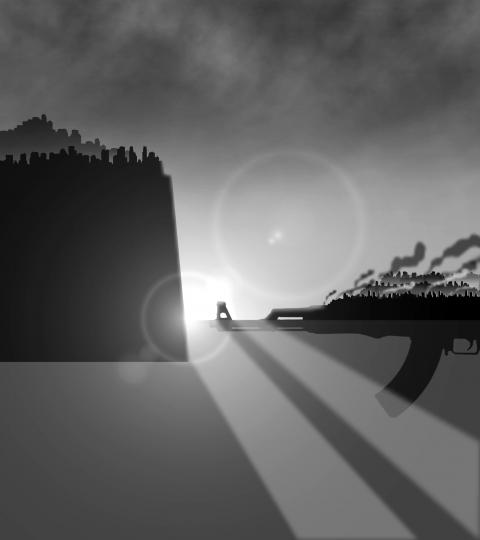By day Nguyen Thi Hoa sold conical hats on the streets of Hue in southern Vietnam, at night she funneled secrets to communist army handlers who were poised to launch an audacious assault on the city that would reshape the Vietnam War.
Hoa was part of the Perfume River Unit, a top-secret female combat unit formed in 1967 and bound by the communist propaganda slogan “When the enemy comes to your home, even the women should fight.”
Deployed deep in enemy territory, the covert 11-strong unit played an instrumental role in the Tet offensive of 1968, despite most of them being in their teens.

Illustration: Yusha
The offensive — whose 50th anniversary is to be marked on Jan. 31 with an official ceremony in Ho Chi Minh City — was a military failure for the northern forces.
However, it swung US public opinion decisively away from the anti-communist fight, ultimately leading to the US pullout. Women were integral to the communist North’s battle against the US “foreign invaders,” working mainly in non-combat roles for most of the war as spies and guides, cooks and messengers, mules and nurses for the injured.
LIBERATION
Using her cover as a street trader, Hoa gleaned details on enemy movements in the strategically important imperial city of Hue, feeding information to commanders from the North.
It was a role driven by conviction in the communist cause.
“I wanted to liberate myself, liberate my homeland, and liberate other women ... there was no other path besides joining the revolution,” she said in Hue, where she settled after the war.
She was just 17 when she joined the war effort as a spy and secret messenger in 1965.
Two years later, she joined the Perfume River Unit, named after the waterway that intersects Hue, a role so risky that she did not even tell her family.
War came to Hue, then the third-largest city in Vietnam, in the early hours of Jan. 31, 1968.
It was a key target of the Tet offensive — a series of surprise attacks across southern Vietnam by more than 80,000 North Vietnamese and Viet Cong fighters. The attacks, which also hit Saigon, stunned US troops and their South Vietnam allies.
Casualties were massive for both sides, especially the North, which lost an estimated 58,000 people.
The shock assault on Hue saw the citadel swiftly fall to the North and for days a blue and red flag with a bright yellow star — a symbol of communist Hanoi and its allies — flew proudly over the city.
However, US Marines and southern troops countered, taking 26 days to wrest back the city block by block in a battle that would become the longest and one of the bloodiest of the Vietnam War.
With casualties high, the Perfume River Unit was called on to join the fight. Until then, they had mostly been ferrying injured fighters from the front line. The women dug in around markets and the sports stadium.
Hurling grenades and shooting her AK-47, it was a battle for survival, Hoa said.
“We just kept shooting ... if we didn’t shoot, they would have shot us, so we just kept fighting,” said Hoa, 69, who was doused in the defoliant Agent Orange during the war and later gave birth to a disabled son.
DESPERATION
The use of female fighters “shows how desperate they [the North Vietnamese] were,” said Mark Bowden, author of Hue 1968. “Every hand was thrown into the fight and at that point these young women fought.”
Their efforts were recognized in a poem by Hanoi’s revolutionary leader Ho Chi Minh, who died in 1969 before the war’s end, praising them for having “crushed the bones” of US soldiers and crystalizing their heroism, which is still celebrated today.
“When we received that letter, everyone cried,” fellow Perfume River Unit fighter Hoang Thi No, 68, said at her home in Hue, sitting under a commemorative plate of “Uncle Ho.”
“We didn’t expect it, we were just a small unit — and so many people died,” she said.
The nod from Uncle Ho came too late for four members of the unit who perished during the battle for Hue.
“My comrades died ... and our anger mounted, as did our determination to fight to get revenge for our sisters,” the soft-spoken grandmother said.
Two more died later in the war — but five are still alive. No and Hoa regularly visit the cemetery where some of their fallen comrades are buried on the outskirts of Hue, a city transformed from a pile of rubble 50 years ago to a tourist hotspot today.
Although they were not the only women to take up arms in the Vietnam War, their reputation as fierce fighters inspired others to join the war — both as soldiers and behind the frontlines.
“The Perfume River Unit ... was a source of motivation for liberation soldiers and other women to join the war effort,” said Cao Huy Hung, director of the Revolutionary Museum in Hue. “If soldiers hadn’t gotten support from women, I don’t think that we could have held out in Hue for 26 days, maybe just a week maximum.”

China has not been a top-tier issue for much of the second Trump administration. Instead, Trump has focused considerable energy on Ukraine, Israel, Iran, and defending America’s borders. At home, Trump has been busy passing an overhaul to America’s tax system, deporting unlawful immigrants, and targeting his political enemies. More recently, he has been consumed by the fallout of a political scandal involving his past relationship with a disgraced sex offender. When the administration has focused on China, there has not been a consistent throughline in its approach or its public statements. This lack of overarching narrative likely reflects a combination
US President Donald Trump’s alleged request that Taiwanese President William Lai (賴清德) not stop in New York while traveling to three of Taiwan’s diplomatic allies, after his administration also rescheduled a visit to Washington by the minister of national defense, sets an unwise precedent and risks locking the US into a trajectory of either direct conflict with the People’s Republic of China (PRC) or capitulation to it over Taiwan. Taiwanese authorities have said that no plans to request a stopover in the US had been submitted to Washington, but Trump shared a direct call with Chinese President Xi Jinping (習近平)
Heavy rains over the past week have overwhelmed southern and central Taiwan, with flooding, landslides, road closures, damage to property and the evacuations of thousands of people. Schools and offices were closed in some areas due to the deluge throughout the week. The heavy downpours brought by the southwest monsoon are a second blow to a region still recovering from last month’s Typhoon Danas. Strong winds and significant rain from the storm inflicted more than NT$2.6 billion (US$86.6 million) in agricultural losses, and damaged more than 23,000 roofs and a record high of nearly 2,500 utility poles, causing power outages. As
The greatest pressure Taiwan has faced in negotiations stems from its continuously growing trade surplus with the US. Taiwan’s trade surplus with the US reached an unprecedented high last year, surging by 54.6 percent from the previous year and placing it among the top six countries with which the US has a trade deficit. The figures became Washington’s primary reason for adopting its firm stance and demanding substantial concessions from Taipei, which put Taiwan at somewhat of a disadvantage at the negotiating table. Taiwan’s most crucial bargaining chip is undoubtedly its key position in the global semiconductor supply chain, which led